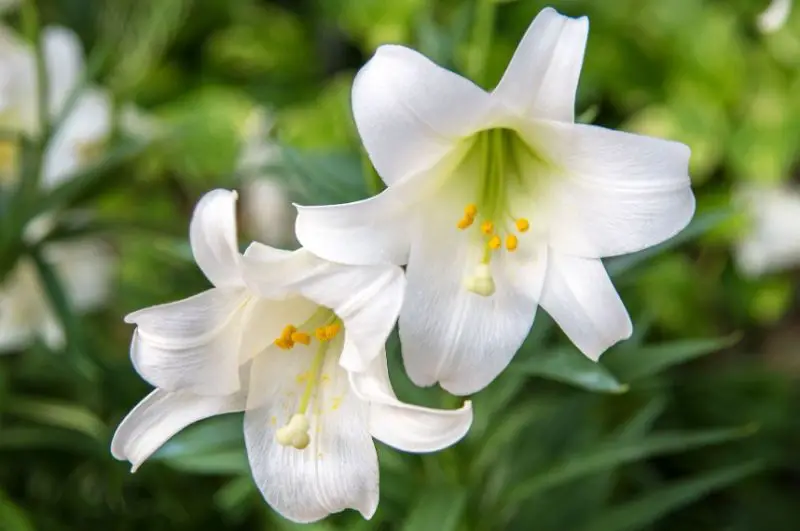Easter Lily (Lilium longiflorum) is a stunning and fragrant flowering plant that symbolizes purity, hope, and renewal. Popularly associated with Easter celebrations, this trumpet-shaped white flower is widely cultivated as both an ornamental and a potted plant.
In this guide, we will explore everything you need to know about growing and caring for Easter Lilies, from planting to maintenance and troubleshooting common issues.
Understanding Easter Lily (Lilium longiflorum)

Easter Lily is a perennial bulbous plant belonging to the Liliaceae family. Native to the Ryukyu Islands of Japan and Taiwan, it has been extensively cultivated in the United States, especially along the Pacific Coast.
This plant is renowned for its striking trumpet-shaped flowers, which emit a delightful fragrance that can fill any space with an aura of freshness and serenity. The flowers are usually pure white, symbolizing purity and rebirth, making them a staple in Easter and religious celebrations.
Growing up to three feet tall, the Easter Lily has long, lance-shaped green leaves that provide an elegant contrast to its delicate blooms. It is known for its ability to adapt to a variety of conditions, but to thrive, it requires proper care and attention.
Characteristics of Easter Lily
The botanical name of the Easter Lily is Lilium longiflorum, but it is also known as the Trumpet Lily due to the shape of its blossoms. As a perennial bulb, it grows back each year if properly cared for.
The mature plant reaches a height of one to three feet, making it a versatile choice for gardens and indoor arrangements. Easter Lilies bloom in spring to early summer, producing large, white, trumpet-like flowers that stand out against the plant’s deep green foliage.
The flowers not only serve as visual highlights but also emit a sweet and soothing fragrance. The plant is well-suited for USDA hardiness zones 4-9, meaning it can survive in a variety of climates as long as it is provided with appropriate care and protection during extreme conditions.
How to Grow Easter Lily
Choosing the Right Location
Easter Lilies thrive best when planted in a location that receives full sunlight for at least six hours a day. Sunlight is essential for healthy growth, and while the plant can tolerate some shade, too much shade will result in weak stems and fewer flowers.
However, in regions where the afternoon sun is particularly intense, partial shade can help protect the plant from scorching. Ideally, the planting site should also have good air circulation, as stagnant air can encourage fungal infections.
When selecting a location, consider an area with well-draining soil, as excessive moisture retention can lead to root rot, a common issue that affects lily bulbs.
Soil Preparation
The ideal soil for Easter Lilies should be well-draining, rich in organic matter, and have a slightly acidic to neutral pH, ranging from 6.0 to 7.0. The soil should be loose and aerated to ensure that the roots can spread easily and absorb nutrients efficiently.
Before planting, it is advisable to amend the soil with compost or aged manure to enhance its fertility and structure. Organic matter improves moisture retention while preventing waterlogging, which can be detrimental to the bulbs.
If the soil is too clay-heavy, consider mixing in sand or peat moss to improve drainage. Testing the soil’s pH beforehand can help determine whether any additional amendments, such as lime or sulfur, are necessary to achieve optimal conditions for growth.
Planting Easter Lily Bulbs
The best time to plant Easter Lily bulbs is in the fall or early spring. When planting, dig a hole that is about six to eight inches deep to provide adequate space for root development.
The bulbs should be spaced approximately eight to twelve inches apart to allow for sufficient airflow and to prevent overcrowding. When placing the bulbs in the soil, make sure the pointed tip faces upward, as this is where the shoots will emerge.
Once positioned correctly, cover the bulbs with soil, gently pressing down to eliminate air pockets. After planting, water thoroughly to help settle the soil and establish initial moisture levels.
To further support healthy growth, apply a layer of mulch around the bulbs to retain moisture, suppress weeds, and regulate soil temperature. Organic mulch, such as wood chips or straw, works well in maintaining a stable environment for the developing plants.
Caring for Easter Lilies
Watering Requirements
Easter Lilies require moderate watering to thrive. The soil should be kept evenly moist but never soggy, as excessive moisture can lead to bulb rot.
It is essential to water the plant deeply but infrequently, ensuring that moisture reaches the root zone rather than just wetting the surface. During dry spells or hot weather, additional watering may be necessary, but always check the soil before adding more water.
A good way to determine if watering is needed is to insert a finger into the soil; if the top inch feels dry, it is time to water. Overhead watering should be avoided, as wet foliage can encourage fungal diseases. Instead, water at the base of the plant to direct moisture straight to the roots.
Fertilization
To encourage healthy growth and abundant blooms, Easter Lilies benefit from regular fertilization. A balanced fertilizer with equal parts nitrogen, phosphorus, and potassium, such as a 10-10-10 formula, works well.
Fertilization should begin in early spring when new growth appears. Apply fertilizer every four to six weeks during the active growing season, ensuring that it is well incorporated into the soil.
Once the flowers begin to fade, fertilization can be discontinued, as excessive nutrients are no longer necessary at this stage. Organic options, such as compost tea or fish emulsion, can also provide the plant with essential nutrients without the risk of over-fertilization.
Pest and Disease Management
Easter Lilies, like many other plants, can be affected by pests and diseases. Common pests include aphids, lily beetles, and spider mites. These pests can cause damage to the leaves and flowers by sucking sap or chewing foliage. To control them, regularly inspect plants and use insecticidal soap or neem oil if infestations become severe.
Fungal diseases, such as botrytis blight and root rot, can develop in overly moist or poorly ventilated conditions. To prevent these issues, ensure proper spacing, avoid overhead watering, and remove any diseased plant material promptly. If necessary, use a fungicide to protect the plant from further infection.
Another common issue is basal rot, which affects the bulbs and can lead to wilting and yellowing of foliage. Prevent basal rot by planting bulbs in well-draining soil and avoiding excessive watering.
Mulching
Applying mulch around the base of the plant offers numerous benefits. A two-to-three-inch layer of mulch helps retain moisture, reducing the frequency of watering.
It also acts as a barrier against weeds, which compete for nutrients and water. Additionally, mulch insulates the soil, keeping it cooler during hot summer months and preventing extreme temperature fluctuations.
When applying mulch, be sure to leave some space around the base of the plant to prevent moisture buildup against the stems, which can lead to rot.
Staking
Tall varieties of Easter Lilies, especially those grown in windy locations, may require staking to prevent bending or breaking.
To provide support, insert a stake into the soil near the plant and use soft ties to secure the stem. Avoid tying too tightly, as this can damage the plant’s delicate tissue.
Regularly check the ties and adjust them as needed as the plant grows.
Conclusion
Easter Lilies (Lilium longiflorum) are beautiful and easy-to-care-for plants that add elegance to any garden or home.
By following the right planting and maintenance practices, you can enjoy their stunning blooms year after year. Whether grown indoors or in the garden, these timeless flowers bring joy and serenity to any space.
With proper care, they will reward you with their exquisite fragrance and delicate white blossoms, making them a cherished addition to any plant collection.






